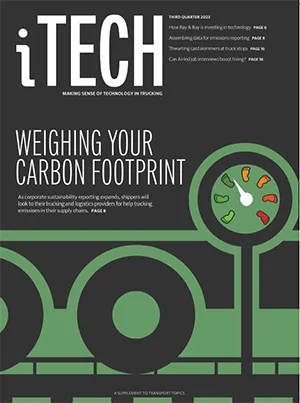Special to Transport Topics
University of Tennessee Develops Fleet Sustainability Index

[Find the latest in trucking technology: Explore this quarter's issue of iTECH]
One of the most difficult hurdles to reliable and auditable greenhouse gas emissions reporting for supply chains is the sheer number of trucks, warehouses and other emissions sources that need to be considered.
Collecting and calculating truck emissions appears particularly daunting for upcoming Scope 3 reporting, as well as supporting Scope 1 needs. The U.S. trucking industry comprises hundreds of thousands of operators and millions of trucks of numerous makes, models, configurations, uses and age.
Given that complexity, is there an effective way to bring the data together and deliver it efficiently and accurately?
Alex Scott, associate professor of supply chain management at the University of Tennessee-Knoxville’s Haslam College of Business, thinks the school has found an answer.
The University of Tennessee Fleet Sustainability Index, built on a database created by the university, contains emissions profiles for more than 400,000 motor carriers and millions of trucks, including private fleets.

Q3 iTECH
►Industry Tackles Carbon Tracking
►Fleets Test Carbon Capture System
►UT Unveils Fleet Sustainability Index
►Card Skimming at Truck Stops
►Q and A: Bay & Bay's Wade Anderson
►Dysart: Using AI for Job Interviews
►Clevenger: Roads to Decarbonization
Explore the Issue!
The index collects and consolidates available data from sources including the U.S. Department of Transportation, the U.S. Environmental Protection Agency and the National Highway Traffic Safety Administration. It then applies proprietary calculations to mine the data and come up with a unique “emissions factor,” down to the granular fleet or truck level.
Scott described the index as “a science-based, data-driven method to accurately estimate a shipper’s Scope 3 truck emissions.”
“What this solution solves,” he said, “is if you are using 100 carriers and brokers, it gets around all those entities having to talk to each other directly.”
The third-party data available through the index enables shippers to determine emissions levels based on the specific carriers they are using.
Strategies for meeting Scope 3 reporting needs ultimately come down to a tradeoff “between the granularity of the data, the accuracy of the measure, and the cost of collecting, storing, updating and maintaining the data,” Scott said.
He believes the index ticks all those boxes and provides a workable solution that can be utilized by carriers and shippers.

Scott
“The shipper needs to know the carriers they use, and the miles their freight runs with those carriers,” Scott explained. “If you have that, we can go into the UT database, which is constantly being updated and refreshed with the latest data, input your information, and get an emissions factor from which you can calculate a number, for example, tons of CO2 per mile, by carrier, type of truck, or lane run.”
The data would enable shippers to consider carbon impact measurements such as kilograms of CO2 per mile as criteria for carrier selection decisions.
In one example, Scott described three fleets each running one million miles. The fleet with the lowest emissions factor generated 5.9% fewer Scope 3 emissions than the other two.
“In a realistic supply chain, that could reduce CO2 emissions by millions of kilograms a year. Those type of results would reward and incentivize shippers to adopt cleaner carriers,” he said.
“A sound Scope 3 measurement system could empower consumers, investors and governments to influence shippers, who then influence carriers,” he argued.
The index already has one major industry supporter. Visibility platform operator Project44 has partnered with the university in a service offering to its customers.
Want more news? Listen to today's daily briefing below or go here for more info:




